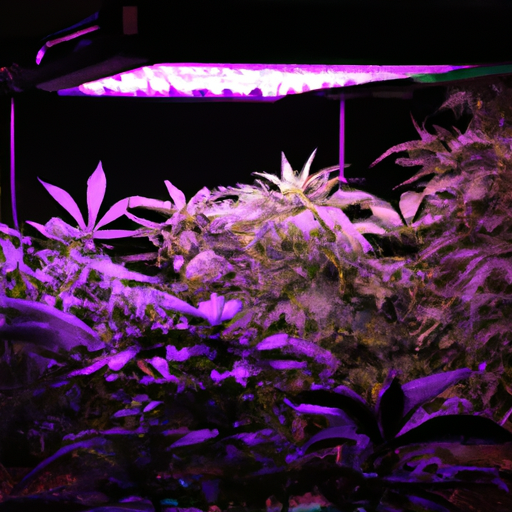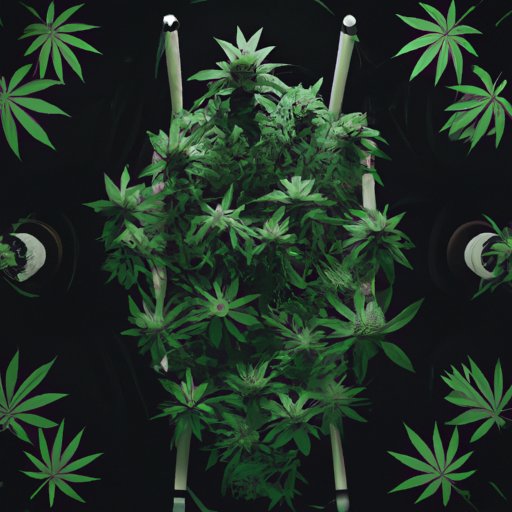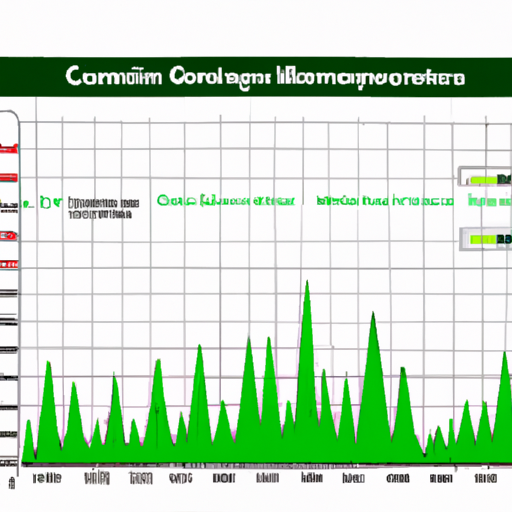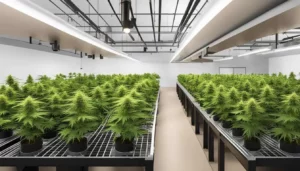In the ever-growing field of cannabis cultivation, indoor growing presents unique challenges and opportunities. This blog post explores various strategies to optimize your indoor cannabis grow area, focusing on effective space management, equipment placement, and environmental control to maximize yield and quality. With a blend of science and practical experience, we delve into the world of 'indoor cannabis space optimization' and 'cannabis grow area management'.
1. The Importance of Indoor Cannabis Space Optimization: Why Does It Matter?
Indoor cannabis space optimization is a critical aspect of successful cultivation. Maximizing the use of available space is essential for achieving higher yields and maintaining the overall health of your plants. By efficiently managing your grow area, you can create an environment that promotes optimal growth and development.
One of the primary reasons why indoor cannabis space optimization matters is the limited amount of space available. Unlike outdoor cultivation, where plants have unlimited room to spread their roots and branches, indoor growers often have to work with confined spaces. Therefore, it becomes crucial to make the most out of every square inch.
Additionally, proper space management allows for better control over environmental factors such as lighting, temperature, and ventilation. By strategically arranging your plants and equipment, you can ensure that each plant receives an adequate amount of light and airflow. This can significantly impact the quality and quantity of your harvest.
Furthermore, optimizing your grow area can also enhance workflow efficiency. By organizing your plants and equipment in a logical and systematic manner, you can streamline your cultivation process. This can save you time and effort in tasks such as watering, pruning, and monitoring plant health.
Finally, indoor cannabis space optimization plays a crucial role in preventing disease and pest infestations. Proper spacing between plants allows for better air circulation, reducing the risk of mold and mildew. It also makes it easier to spot and address any pest issues before they spread throughout the entire growing area.

1. An image of an efficiently arranged indoor cannabis grow area, showcasing the effective use of space.
2. 'Space is the breath of art.' – Frank Lloyd Wright: Applying This to Your Cannabis Grow Area
When it comes to designing and optimizing your cannabis grow area, the quote by Frank Lloyd Wright, "Space is the breath of art," holds true. Just as a well-designed space can enhance the beauty and functionality of a work of art, applying this concept to your grow area can lead to a more efficient and productive cultivation environment.
First, consider the layout of your grow space. Just as an artist carefully arranges elements within a canvas, you should strategically plan the placement of your plants, equipment, and pathways. This will ensure that each plant has sufficient space to grow and receive the necessary resources while allowing for easy access for maintenance and harvesting.
Secondly, think about the flow of air and light in your grow area. Similar to how a painter considers the lighting in their studio, you need to optimize the distribution of light and airflow to each plant. This can be achieved by positioning your lights and fans in a way that maximizes coverage and minimizes shadows. Adequate air circulation is essential for preventing the buildup of heat and humidity, which can lead to mold and other plant health issues.
Lastly, don't forget about the aesthetic aspect of your grow area. Just as an artist carefully selects colors and textures, you can incorporate design elements into your cultivation space. Consider using reflective materials to increase light intensity or adding plants for decoration. A visually appealing space can create a positive atmosphere and contribute to the overall enjoyment of your growing experience.
3. Lighting and Space: How to Get the Balance Right?
When it comes to indoor cannabis cultivation, lighting plays a crucial role in the growth and development of plants. However, finding the right balance between lighting and space is essential to ensure optimal plant health and yield. Here are some key considerations to help you achieve the perfect balance:
- 1. Choosing the Right Lighting System:
The first step in achieving the right balance is selecting the appropriate lighting system for your grow area. LED grow lights, high-intensity discharge (HID) lights, and fluorescent lights are popular options. Each has its advantages and considerations, such as energy efficiency, heat output, and light spectrum. Evaluate the specific needs of your plants and consider factors like cost and efficiency to determine the best lighting system for your space. - 2. Calculating Light Intensity and Coverage:
Once you have chosen the lighting system, it's crucial to calculate the light intensity and coverage needed for your plants. Different stages of growth require varying light levels. Seedlings and clones, for example, typically require lower light levels compared to flowering plants. Consider the light output of your chosen system, the height of the canopy, and the recommended light intensity for each stage of growth. This will help you determine the optimal placement and spacing of your lights to ensure even coverage and avoid light burn or deficiencies. - 3. Managing Heat and Light Distribution:
Another aspect to consider is managing heat and light distribution within your grow area. The intensity of the light source can generate heat, which can negatively impact plant health if not properly managed. Ensure that your growing space has adequate ventilation and airflow to dissipate heat effectively. Additionally, consider using reflective materials or light hoods to direct and distribute light evenly across your plants. This will help prevent hotspots and optimize light absorption.

3. A photo of an indoor grow area with optimized lighting, highlighting the even distribution of light across all plants.
4. Ventilation and Temperature Control: Are You Overlooking These Crucial Factors?
Proper ventilation and temperature control are often overlooked aspects of indoor cannabis cultivation, but they play a critical role in creating an optimal growing environment. Without adequate airflow and temperature regulation, plants can suffer from issues such as mold, pests, and stunted growth. Here are some key considerations to ensure effective ventilation and temperature control in your cannabis grow area:
- 1. Air Exchange and Circulation:
Adequate air exchange is essential for maintaining a healthy growing environment. Stagnant air can lead to the buildup of excess humidity, which can promote the growth of mold and mildew. Ensure that your grow area has proper ventilation systems in place, such as exhaust fans and intake vents, to facilitate the exchange of fresh air. Additionally, consider using oscillating fans to promote air circulation within the canopy, helping to strengthen plants and prevent the development of weak stems. - 2. Temperature Regulation:
Maintaining the ideal temperature range is crucial for healthy plant growth. Cannabis plants thrive in temperatures between 70-85°F (21-29°C) during the day and slightly cooler temperatures at night. Invest in a reliable thermometer and monitor temperatures regularly. If the temperature exceeds the ideal range, consider using cooling equipment such as air-conditioning units or evaporative coolers. On the other hand, if temperatures are too low, you may need to use heaters or adjust the positioning of your lights to provide additional warmth. - 3. Humidity Control:
Alongside temperature, humidity levels also play a significant role in plant health. High humidity can create an environment conducive to mold and mildew growth, while low humidity can cause plants to dry out and become stressed. Aim for a relative humidity (RH) level between 40-60% during the vegetative stage and slightly lower (around 40-50%) during the flowering stage. Use dehumidifiers or humidifiers to adjust humidity levels as necessary, and make sure to monitor and maintain proper airflow to prevent excessive moisture buildup. - 4. Carbon Dioxide (CO2) Levels:
Finally, consider the importance of carbon dioxide (CO2) levels in your grow area. CO2 is an essential component for photosynthesis and can significantly impact plant growth and yield. Ensure that your grow space has adequate CO2 levels, typically around 1200-1500 parts per million (ppm), to enhance plant growth and maximize yields. CO2 supplementation systems can be used to achieve optimal levels, but be sure to monitor and control CO2 levels carefully to avoid overexposure.
5. Maximizing Vertical Space: The Future of Indoor Cannabis Growing?
As the demand for indoor cannabis cultivation continues to rise, maximizing vertical space has become a key consideration for growers. With limited floor space, utilizing vertical space is a practical solution to optimize yields and increase overall efficiency. By implementing vertical growing techniques, cultivators can take advantage of every inch of their growing area, potentially doubling or even tripling their production capacity.
One popular method for maximizing vertical space is the use of vertical growing systems such as trellis netting, SCROG (Screen of Green), or vertical hydroponic towers. These systems allow cannabis plants to grow horizontally along a screen or trellis, creating a uniform canopy that maximizes light penetration and increases bud production.
Additionally, vertical growing systems can be combined with other cultivation techniques such as Sea of Green (SOG) or High-Pressure Aeroponics (HPA) to further optimize space. SOG involves growing a large number of smaller plants, while HPA utilizes a system that mist sprays nutrient-rich water directly onto the roots, eliminating the need for soil and conserving space.
Another aspect of maximizing vertical space is the use of adjustable lighting systems. By utilizing adjustable LED lights or light movers, growers can position their lights at different heights to accommodate the varying growth stages of cannabis plants. This ensures that all parts of the canopy receive optimal light, promoting even growth and maximizing yield potential.
In addition to increasing production capacity, maximizing vertical space also offers benefits in terms of energy efficiency and cost-effectiveness. By utilizing vertical growing techniques, growers can reduce their overall footprint, resulting in lower energy consumption and operating costs. This not only benefits the environment but also improves the economic viability of indoor cannabis cultivation.

5. An image of a vertical cannabis growing setup, showcasing the potential of utilizing vertical space.
6. Equipment Placement: How to Arrange for Maximum Efficiency?
Efficient equipment placement is crucial for optimizing your indoor cannabis grow area. Proper arrangement not only ensures a smooth workflow but also maximizes productivity and minimizes potential hazards. When planning the layout of your grow area, consider the following tips to achieve maximum efficiency.
First and foremost, prioritize accessibility. Arrange your equipment in a way that allows easy access for maintenance, monitoring, and harvesting. This includes positioning grow lights, fans, and irrigation systems in convenient locations. By minimizing the need to maneuver around obstacles or crawl into tight spaces, you can save time and effort.
Next, consider the flow of air and water. Proper ventilation is essential for maintaining optimal humidity levels and preventing the buildup of heat or stagnant air. Place fans strategically to promote air circulation and ensure that they are not obstructed by other equipment. Similarly, position your irrigation system to provide uniform water distribution to all plants, avoiding any pooling or uneven watering.
Furthermore, it is important to separate different stages of the cultivation process. Designate specific areas for propagation, vegetative growth, and flowering to streamline operations and minimize the risk of cross-contamination. This allows for targeted environmental control and tailored nutrient regimens for each stage, ultimately enhancing the overall quality of your crop.
Finally, consider the safety aspects of equipment placement. Ensure that electrical cords and outlets are properly managed to prevent tripping hazards and potential accidents. Keep flammable materials away from heat sources and ensure that fire extinguishers are easily accessible. By prioritizing safety, you not only protect yourself and your team but also safeguard your valuable investment.
7. Keeping Track of Your Grow Area: What Management Strategies Work Best?
In order to optimize your indoor cannabis grow area, it is essential to implement effective management strategies. Keeping track of various aspects of your grow area allows you to monitor and adjust conditions to ensure the best possible results. Here are some management strategies that work best for maintaining a well-organized and successful grow area.
First and foremost, keeping detailed records is crucial. Documenting important information such as nutrient schedules, watering patterns, and environmental conditions allows you to track the progress of your plants and identify any potential issues. This data can also be used for future reference or analysis, enabling you to make informed decisions and adjustments to optimize your grow area.
Implementing a strict schedule for routine tasks is another effective management strategy. This includes tasks such as watering, pruning, and pest control. By establishing a consistent schedule, you ensure that all necessary tasks are performed in a timely manner, reducing the risk of neglect or oversight. This also helps to maintain a structured workflow and prevents tasks from piling up, which can lead to unnecessary stress and potential problems in your grow area.
Utilizing technology and automation can greatly enhance your management strategies. There are various software and mobile applications available that allow you to remotely monitor and control environmental factors such as temperature, humidity, and lighting. These tools provide real-time data and notifications, enabling you to promptly address any issues and make necessary adjustments, even when you are not physically present in the grow area.
Additionally, implementing a system for plant labeling and organization is essential. By clearly labeling and categorizing your plants, you can easily track their progress and ensure that they receive the appropriate care and attention. This also helps to prevent any confusion or mix-ups, particularly if you are growing different strains or varieties.

7. An illustration of a tracking chart for managing an indoor cannabis grow area, demonstrating the importance of constant monitoring and adjustments.
Optimizing Your Indoor Cannabis Grow Area:
| Strategy | Action | Benefits | Tips |
|---|---|---|---|
| Space Management | Assess your space and consider how to best use it for your grow area | Maximize efficiency and yield | Make sure to leave room for equipment and ventilation |
| Equipment Placement | Determine the best placement for your equipment, such as lighting, fans, and humidity control | Maintain optimal environmental conditions | Keep your equipment away from windows and direct sunlight |
| Environmental Control | Use temperature and humidity control systems to maintain ideal conditions | Optimize plant growth and maximize yield | Monitor and adjust your systems regularly |
| Air Flow | Ensure proper air flow in your grow area | Prevent mold, mildew, and other pathogens | Use fans to circulate air and open windows when possible |
Optimizing your indoor cannabis grow area is not just about maximizing space. It's about creating an environment that allows your plants to thrive. By paying attention to lighting, ventilation, temperature, and humidity, you can tailor your grow space to meet the specific needs of your cannabis plants. With proper planning and management, you can turn any space into a high-production, efficient indoor cannabis garden.





